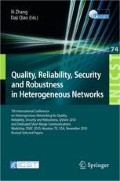Abstract
The Traffic Probe Message Service uses vehicle-to-roadside wireless communication to collect kinematic and other state data from participating vehicles. The draft standard requires vehicles to use pseudonymous identifiers in order to hide their identity. Whenever vehicles transmit state data to base stations called roadside equipment, the vehicles change their identifier and halt the collection of state data for a random period. These changes are designed to prevent a de-anonymization attack from reconstructing a vehicle’s path through the road network. Thus, the roadside equipment creates mix zones, which given enough vehicles within a zone and sufficient changes in vehicle mobility patterns, can reduce the success of de-anonymization attacks. In highway scenarios, optimal mixing is likely in the regions near highway interchanges. This paper hypothesizes that given the rules snapshot generation, the optimal place for pseudonym changes is upstream of the middle of an interchange. Simulations of various traffic conditions in a large highway scenario support this hypothesis, and suggest that roadside equipment be placed such that they create pseudonym changes at these locations in order to maximize the ability of mix zones to mitigate de-anonymization threats.
Access this chapter
Tax calculation will be finalised at checkout
Purchases are for personal use only
Preview
Unable to display preview. Download preview PDF.
References
DSRC Committee. DRAFT SAE J2735 Dedicated Short Range Communications (DSRC) Message Set Dictionary: Annex B: Traffic Probe Message Use and Operation. Society of Automotive Engineers, Warrendale, PA (2007)
Krumm, J.: A survey of computational location privacy. Personal and Ubiquitous Computing 13(6), 391–399 (2009)
Hoh, B., Gruteser, M., Xiong, H., Alrabady, A.: Enhancing security and privacy in traffic-monitoring systems. IEEE Pervasive Computing Magazine, 38–46 (2006)
Gruteser, M., Hoh, B.: On the anonymity of periodic location samples. In: Hutter, D., Ullmann, M. (eds.) SPC 2005. LNCS, vol. 3450, pp. 179–192. Springer, Heidelberg (2005)
Huang, L., Matsuura, K., Yamane, H., Sezaki, K.: Towards modeling wireless location privacy. In: Danezis, G., Martin, D. (eds.) PET 2005. LNCS, vol. 3856, pp. 59–77. Springer, Heidelberg (2006)
Beresford, A.R., Stajano, F.: Location privacy in pervasive computing. IEEE Pervasive Computing Magazine, 46–55 (2003)
Meyerowitz, T.J., Choudhury, R.R.: Realtime location privacy via mobility prediction: creating confusion at crossroads. In: 10th Workshop on Mobile Computing Systems and Applications, pp. 1–6 (2009)
Li, M., Sampigethaya, K., Huang, L., Poovendran, R.: Swing & swap: user-centric approaches towards maximizing location privacy. In: ACM Workshop on Privacy in Electronic Society, pp. 19–28 (2006)
Blum, J.J., Okusun, P.O.: Privacy Implications of the Traffic Probe Message Service. In: IEEE Intelligent Transportation Systems Conference, pp. 342–347 (2010)
Owen, L.E., Zhang, Y., Rao, L., McHale, G.: Traffic flow simulation using CORSIM. In: Winter Simulation Conference, vol. 2, pp. 1143–1147 (2000)
Petty, K.: FSP 1.1: The Analysis Software for the FSP Project. University of California, Berkeley, Berkeley, CA (1994)
Author information
Authors and Affiliations
Editor information
Editors and Affiliations
Rights and permissions
Copyright information
© 2012 ICST Institute for Computer Science, Social Informatics and Telecommunications Engineering
About this paper
Cite this paper
Blum, J.J., Okosun, P.O. (2012). Maximizing Mix Zone Effectiveness for the Mitigation of De-anonymization Threats in the Traffic Probe Message Service. In: Zhang, X., Qiao, D. (eds) Quality, Reliability, Security and Robustness in Heterogeneous Networks. QShine 2010. Lecture Notes of the Institute for Computer Sciences, Social Informatics and Telecommunications Engineering, vol 74. Springer, Berlin, Heidelberg. https://doi.org/10.1007/978-3-642-29222-4_42
Download citation
DOI: https://doi.org/10.1007/978-3-642-29222-4_42
Publisher Name: Springer, Berlin, Heidelberg
Print ISBN: 978-3-642-29221-7
Online ISBN: 978-3-642-29222-4
eBook Packages: Computer ScienceComputer Science (R0)

